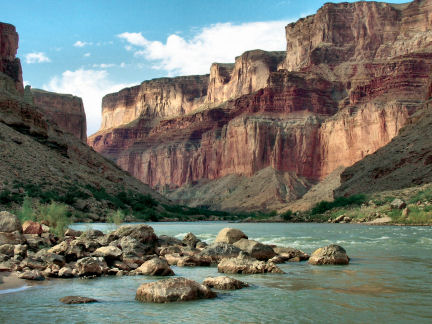Deep history
Scientists have gained new clues about when the Grand Canyon formed.
Share this:
- Share via email (Opens in new window) Email
- Click to share on Facebook (Opens in new window) Facebook
- Click to share on X (Opens in new window) X
- Click to share on Pinterest (Opens in new window) Pinterest
- Click to share on Reddit (Opens in new window) Reddit
- Share to Google Classroom (Opens in new window) Google Classroom
- Click to print (Opens in new window) Print
By Emily Sohn
The Grand Canyon is one of nature’s most majestic and impressive places. The gorge is enormous, measuring 277 miles (446 kilometers) long and up to a mile (1.6 km) deep in some places. The Colorado River runs through the middle of it. But how old is it?
Now, scientists have collected new clues about the canyon’s age.
 |
|
New studies of mineral formations in caves along the Grand Canyon now indicate that parts of the chasm may be 17 million years old.
|
| J. Powell |
The canyon’s walls are full of caves that contain lumps of minerals called mammillaries. These mound-shaped lumps usually form just below the surface of pools that are full of minerals.
Water levels in such pools can drop when, for example, a change in climate occurs or the Earth’s crust shifts. The mammillaries remain, even when the water level drops. Scientists can analyze concentrations of metals inside the mounds to figure out when their pools went dry.
Carol Hill, a geologist at the University of New Mexico in Albuquerque, and colleagues studied mammillary formations in nine caves near the Grand Canyon. Most of these caves lie within a few miles of the Colorado River, which carved the rocky gorge. All the sampled mounds were within three-quarters of a mile (1.2 km) above the river’s current level.
Analyses of the mounds in the western region of the Grand Canyon suggest that 17 million years ago the level of groundwater in the area was about 3,800 feet (1,160 meters) higher than it is today. By 7.6 million years ago, the water had dropped to 3,050 feet above the river’s current level. About 2 million years ago, the water was only 390 feet (120 m) higher than it is today. Over that time, water levels dropped as the river carved deeper into the canyon’s floor.
In the eastern region of the Grand Canyon, analyses suggest that the river’s carving action started much later but took place far more quickly. In that area, the groundwater level (and probably the river level) dropped almost as far as it did on the western side, 3,000 feet (920 m), but in only one-fifth the time—just the past 3.7 million years.
Together, these data suggest that the Colorado River began carving the Grand Canyon at its western end. Later, the process appears to have continued upstream.
Going Deeper:
Perkins, Sid. 2008. Ancient chasm: Parts of Grand Canyon may be 17 million years old. Science News 173(March 8):147-148. Available at http://www.sciencenews.org/articles/20080308/fob2.asp .







